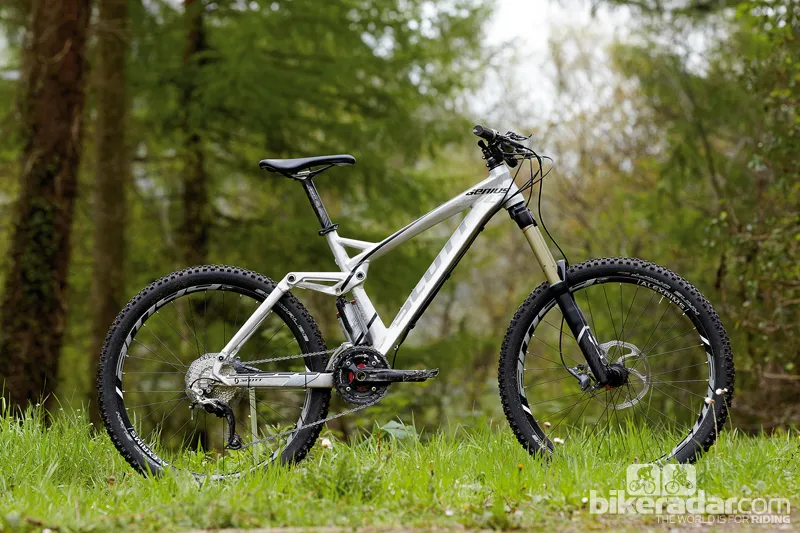Scott’s Genius LT is in its second year of shredding. The LT 40 version needs some component and time investment to get the best from its unique multi-mode personality though.
Ride & handling: More cruiser than bruiser when it comes to trails
Assuming the shock is open, the geometry of the Scott is definitely in your favour when cruising descents. The long front centre and short rear make it easy to lift the front wheel off drops and hard to fall over the front, so launching stuff is simple. It’s slack and low enough for confidently stable speed work in proper mountains or over loose and rocky sections.
The short rear end also follows smartly once you’ve swung the front through a corner, so typically tight trail centre switchbacks aren’t an issue. But start pushing it harder and the narrow bars are definitely under-leveraged for fighting with bigger chunks of trail. Despite the machined dropouts there’s noticeable twist in the rear end when you start shoving it sideways, and the front end can also slide out unless you deliberately push weight forward.
The more sorted we got the suspension the more the structural issues became an issue for our most aggressive riders, reinforcing the conclusion that this bike is best suited to big-mountain cruising rather than really ripping it up.
Frame & equipment: Surprisingly cross-country
The LT frame is a sturdy 7.5lb piece of alloy that MBUK art editor Jimmer campaigned hard all last year, not least in his Megavalanche race week.
It covers all the contemporary ‘proper mountain bike’ bases with its tapered head tube, multi-profile hydroformed tubes, low standover height and ISCG chainguide mounts.
The ‘screw-through’ rear axle is just a skinny captured quick-release skewer, not a proper fat pipe, though there are some other typically neat Scott touches – including space for a conventional bottle cage placement.
The clip-on cable/hose run under the down tube also helps protect the belly of the bike from front wheel rock roost. The really radical part of the bike is the Equalizer 3 shock sitting behind the forward offset seat tube. Not only is it a pull shock – it consists of three separate chambers, one for damping oil and the other two providing different-sized air spring chambers, each with their own rebound damping valve.
These two chambers are opened and shut with a very neat Twin Loc handlebar remote. This closes the large air chamber first – creating a lower volume, more progressive 110mm ‘Traction’ mode – and then both rear chambers and the fork compression damper for a full front and rear lockout.
A switchable shock mount ‘chuck’ also enables you to raise or lower bottom bracket height by 7.6mm and alter the head and seat angles by 0.7 degrees. The fork is a heavily custom modded unit too, extending the normally 160/170mm travel Lyrik chassis to 180mm to match the 185mm rear travel.
The remote lockout is a Scott-only feature and travel can also be manually dropped to 110mm travel to steepen the climbing geometry.
Sturdy Alex rims carry large volume Schwalbe Hans Dampf tyres and the 60mm Scott stem is appropriately stumpy for gravity work. Unfortunately though, the tyres are the cheaper Performance compound – and their lack of grip is lethal, particularly in the wet. That meant we had to switch to the excellent TrailStar compound Evolution versions of the same tyres to get any idea of what the bike could do on climbs or in corners.
The rest of the spec is surprisingly cross-country too. The mixed Shimano transmission is a full 3x10 setup rather than a chainguarded or even bashringed 2x10 or 1x10, and the 700mm bar is narrow for such a long travel bike. The 31.9mm seat tube (rather than Scott’s typical 34.9mm size) allows easy upgrading to a dropper post (cable/hose remote guides are included). There’s no internal interruption to fully slamming the conventional seatpost supplied anyway though.
Given the amount of technology in the Genius LT 40, a longer setup time than normal should be expected – but patience is a virtue with the Scott. On the plus side, the guide pressures marked on the shock chambers are a good starting point. The dipstick-style O-ring stroke indicator on the side makes judging sag relatively easy too. It still took a while to get the small bump sensitivity/end stroke balance right on our initially very linear shock.
The fork is similarly linear, which meant most runs ended up with a couple of full travel moments. Our experience with last year’s LT proves you can get it spot on in the end, although we had two ‘back to Scott’ services in the process.
The remote lever is great for climbing though, and well placed for emergency re-opening if/when you accidentally hit a descent locked out.


